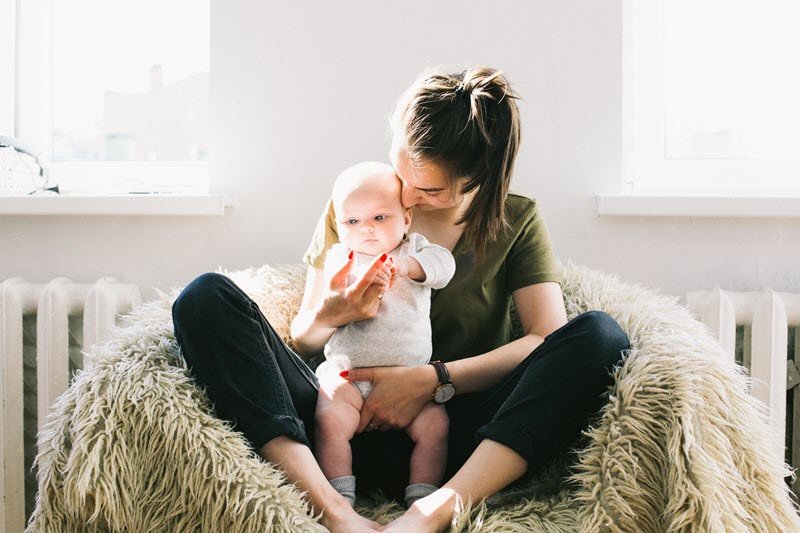When I was pregnant with my first child, I sang to her, gently massaged my belly and had vivid monologues with her, as I felt she could hear me and become familiar with my voice. My husband did that as well and when I gave birth to my baby it was love at first sight! We connected instantly. It seemed like she recognized my husband’s voice as well (and he was so proud!) Even though we may think that babies learn to recognize their name immediately, that is not entirely the case.
Babies recognize mom’s voice at first
I was so anxious to find out when babies recognize their name, with my firstborn! I couldn’t wait to see her turn her head when I call her. What I realized is that it takes around 6 months for babies to start learning and recognizing their names. At first, they only react to the mom’s voice since it is the first and most familiar voice for them. The mom is the baby’s source of reassurance, love, and confidence. In order to teach your baby her name, say her name clearly every time you talk to her – “here is your milk, Sarah” or “would you like to sleep now, Jake?” This will help to build those connections in their brain faster.
View in gallery
Even though the kids love it when we use nicknames such as sweetie or baby, it should be done in moderation because the lack of repetition will make it take longer to learn their names. Also, talk to your baby like she can understand everything – name the objects and everything you show her because the more you talk to her the more she will learn. You’ve probably heard many moms saying things like “mommy will help you” or “here’s daddy!” Well, that is for a good reason – that way babies learn how the proper name for their parents.
How to teach children to respond to their own names
If you’re impatient or just want to help your child advance, there are different methods you can use. Just remember to be patient with them and realize that every child is different and it might not happen when you expect it to. Using love and patience will help them advance quicker and easier. Here are a couple ways to help them respond to their own names:
- Limit using your child’s name throughout the day, especially with demands like “Johnny, put away your shoes” or “Jenny it’s time to get into bed”. This will teach the child not to link their name to things they usually tune out.
- Another good tactic is to gather up some things your child enjoys, like candy or bubbles for example and stand right behind him/her. Call your child’s name, then touch their shoulder and hand them the candy or bubbles. Gradually start further behind them and delay touching their shoulder. Over time this will reinforce the use of their name with something good.
When do toddlers learn to say their names?
Every child is different and unique. Even though there are some milestones that pediatricians look at, it is still not an exact science and greatly depends on the child’s nature and willingness to speak. However, around the 15th month, toddlers start saying a few words and those are usually mom, dad, granny. By the time they are 18 months old, they learn 20 words and this is usually the time when most toddlers start saying their name. If you are anything like me, you will be worried sick if it doesn’t happen, but honestly from this perspective now, I was worrying for nothing. It happened soon after that and I was so relieved!
Feeling worried is completely normal, but I assure you, you will soon realize that your child has his rhythm and that is perfectly fine if your toddler learns other words but can’t say his name. Communication is the key to language learning, so narrate what you are doing, especially when there is something new around. Communicate with your child in a clear voice, without the baby talk, because that may greatly affect the clarity of his speech. Include your child in your everyday routine and explain everything that you are doing. Having a routine that you repeat daily and explain along the way will help your child remember all the new words you are introducing. It is recommended to give short commands at this time that your child can understand, like “put this napkin on the table”. By the time they are 24 months old, they will be able to say up to a hundred words.
When are children ready to write their name?
Around the time when children are 5 years old, they start showing signs that they are ready to write. They usually learn how to hold pen right and then draw crosses, closed circles, and lines. Even though you notice these things, it is not recommended to hurry with teaching your kids to write. It might have an opposite effect from the one you were hoping for. It may result in frustration if there is something that they can’t learn and even cause some issues later on when they start learning writing in school.
What you can do instead is to work on the motor skills of your child. Play-Doh is one of the best ways to do it because by squeezing it, their hands get stronger, but it also develops creativity. Making different shapes and sizes and being engaged in one activity will also help your child to concentrate better later on in school. Also, using small scissors for paper and cutting various shapes will also strengthen the hands and help the child hold the pen correctly later on. Be creative and have fun with your child. If you like to bake, include your child in the process. Even though it will probably last much longer than it would if you do it by yourself, this way you will help your child build confidence and prepare him to face future challenges easier.
Reading books to your child is very important. Not only it will boost their creativity, but it will also help the child to understand how symbols and sounds relate. When your child expresses the wish to learn to write their name, you can start with a capital letter which is easier to learn and then slowly work towards writing the entire name. Play around and use markers of different colors, so that your child can write over it. You can also cut all the letters of your child’s name (or let him do it) and then let him put them in the right order and perhaps even glue them on a piece of paper. It will be fun and engaging activity and certainly easier to remember then to simply write on the paper endlessly.
With so many fun activities that you can engage in with your child, you will help him learn in no time. Be creative and open-minded. Create origami, play games, cut the paper, take colored paper and then make a collage, put stickers on or anything else that your child likes, so you can work together on improving the motor skills. Just remember that this is your special time for bonding as well. Keep the atmosphere relaxed and fun, so your child can look forward to learning. The initial contacts with books and learning are very important to kids.






